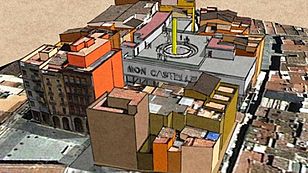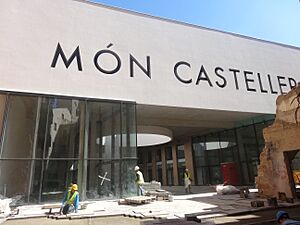Món Casteller Human Tower Museum of Catalonia facts for kids
The Món Casteller. The Human Tower Museum of Catalonia (MCC) is a special museum in Valls, a city in Catalonia. Valls is known as the birthplace of human towers. This museum celebrates the amazing tradition of building human towers. Many groups helped create this museum, including the Catalan Government, the Tarragona County Council, Valls City Hall, and the groups that build human towers.
Contents
How the Museum Idea Started
The idea for a museum about human towers in Valls began a long time ago. A historian and photographer named Pere Català Roca first suggested it in the late 1950s. He wanted a place to share the culture of human towers. He even held exhibitions in Valls and Tarragona in the 1960s to support his idea. He brought up the idea again in big cultural meetings in 1977 and 1982.
The first official meeting for the Human Tower Museum of Catalonia happened on July 26, 1978.
Later, in 1984, the Valls Institute of Studies continued the effort. They set up a small exhibition in 1981 and then a permanent one in 1985. However, the building had problems and had to close after only two years.
In 1997, a new plan for the museum began. Experts from the Catalan Government, Valls City Hall, and the Valls Museum worked together to design it.
Finding a Home for the Museum
For a while, they still hoped to use the old building. But in 2003, they thought about using old military barracks instead. Then, in 2007, Valls City Hall announced another change: they would build a brand new building outside the city center.
On October 17, 2009, the museum project was officially presented to the public. This was a big event with all the groups involved.
In 2010, the first building plans were made. In November of that same year, UNESCO recognized human towers as an Intangible Cultural Heritage of Humanity. This means human towers are a very important part of world culture.
Finally, in 2013, the project changed again. The museum would be built right in the heart of Valls Old Town, in Plaça del Blat. This square is considered the "zero point" for human towers.
Building the Museum
To make space for the museum, 29 old buildings were carefully taken down starting on April 22, 2014. Workers had to do this by hand because the buildings were very old and fragile.
On March 27, 2015, a special event marked the start of construction on the new museum site. Thirty-four human tower groups built small towers (called "pillars") at the same time on the land. Other groups were also there, making it a huge celebration. Groups like the Muixeranga d’Algemesí and Moixiganga de Tarragona, which are similar to human towers and show their origins, also joined. After the towers were built, children from each group placed their team's shield into a special box, like a "first stone" for the museum. Then, a company called Sacude performed an amazing show. They danced vertically on tall scaffolding, showing the important values of human towers: strength, balance, courage, and good sense.
Construction officially began on April 16, 2015. A company called Carbonell Figueres started building the main structure of the museum.
Exploring the Museum
The museum building is designed to connect two important squares, Plaça del Blat and Plaça de l’Oli. It also creates a new, round-shaped plaza that opens up into the old part of the city. A tall, 20-meter pillar of light stands over the building. This light changes colors to show the different shirt colors of the human tower groups.
What You'll Find Inside
- Ground Floor: This is where you'll find the entrance, a gift shop, a cafe, and a special area that uses sights and sounds to make you feel like you're part of a human tower.
- Mezzanine Floor: Here, you'll find educational areas, an archive, and the Human Tower Documentation Centre (CEDOCA). This center keeps all the important information and history about human towers.
- First Floor: This floor has the main museum exhibition, where you can learn all about human towers. There's also a room for temporary exhibitions that change from time to time.
- Basement: This is the office for the Coordinator of Catalan Human Tower Groups.
- Roof: The roof is a viewpoint terrace where you can see amazing views, including the tallest bell tower in Catalonia.
The Museum's Experience
The museum's design is based on the famous motto of human towers: "strength, balance, courage, and good sense." This motto comes from a poem written in 1867. The museum experience is called "A tower in three acts." It uses videos and interactive displays to help you feel the excitement and emotions of a human tower event.
When you first enter, you'll see a huge video display that connects two floors. This part shows the courage of the human tower builders and the feeling of being high up, like the "enxaneta" (the child who climbs to the very top).
The second part of the museum focuses on "good sense" and "balance." This section teaches you about the wisdom, experience, and techniques used in human towers. It also shows how human towers have grown over time, how their techniques have improved, and how Valls became their birthplace. In this area, five round sections guide you through the history with interactive displays.
The last part is about "strength." It ends with a multimedia show that captures the joy and excitement when a human tower is successfully completed. This show uses real videos, computer graphics, and animations to bring the experience to life.
Experts also worked on a "Taula Lèxica" (Lexical Table) to choose the best words and terms related to human towers for the museum.
The Museum's Location in the Old Town
The Món Casteller museum is part of a bigger plan by Valls City Hall to make the city's Old Town better. Like many European cities, Valls wants to improve its old areas by creating new public spaces and updating old buildings. They are also adding new community and cultural centers.
In Valls, this plan has already led to the creation of Espai Ca Creus. This building brings together different services, including a Civic Centre, the City Hall's Culture Department, and a Youth Service. It also houses the Carles Cardó County Library, which opened in 2014.
Videos
Discover the museum's building before setting museography
See also
 In Spanish: Museo Casteller de Cataluña para niños
In Spanish: Museo Casteller de Cataluña para niños



